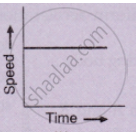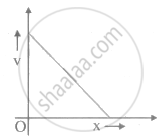Advertisements
Advertisements
प्रश्न
A car of mass 1000 kg is moving with a velocity of 10 m s−1. If the velocity-time graph for this car is a horizontal line parallel to the time axis, then the velocity of car at the end of 25 s will be :
विकल्प
25 m s−1
40 m s−1
10 m s−1
250 m s−1
उत्तर
It is given that the velocity time curve is parallel to x axis hence velocity is constant with time and acceleration is 0. So, the answer is
(c) 10 m s−1
APPEARS IN
संबंधित प्रश्न
Fill in the following blank with suitable word :
In a speed-time graph, the area enclosed by the speed-time curve and the time axis gives the…………….. by the body.
Study the speed-time graph of a car given alongside and answer the following questions:

(i) What type of motion is represented by OA ?
(ii) What type of motion is represented by AB ?
(iii) What type of motion is represented by BC ?
(iv) What is the acceleration of car from O to A ?
(v)What is the acceleration of car from A to B ?
(vi) What is the retardation of car from B to C ?
What type of motion is represented by the following graph ?

Represent the position of a body described as at 15 m, 30o north of west, on a graph paper.
The area of the right triangle under a speed-time graph is 500 m, in a time interval of 20 s. What is the speed of the body? Is the motion uniform or non-uniform?
Interpret the following graph:
State whether true or false. If false, correct the statement.
If the velocity – time graph of a particle is a straight line inclined to X-axis then its displacement – time graph will be a straight line.
The area under the v-t graph represents a physical quantity that has the unit.
A straight line parallel to the x-axis in the velocity-time graph represents the object moving in ______.
The given graph shows the variation of velocity (v) with position (x) for a particle moving along a straight line

Which of the following graph shows the variation of acceleration (a) with position (x)?
